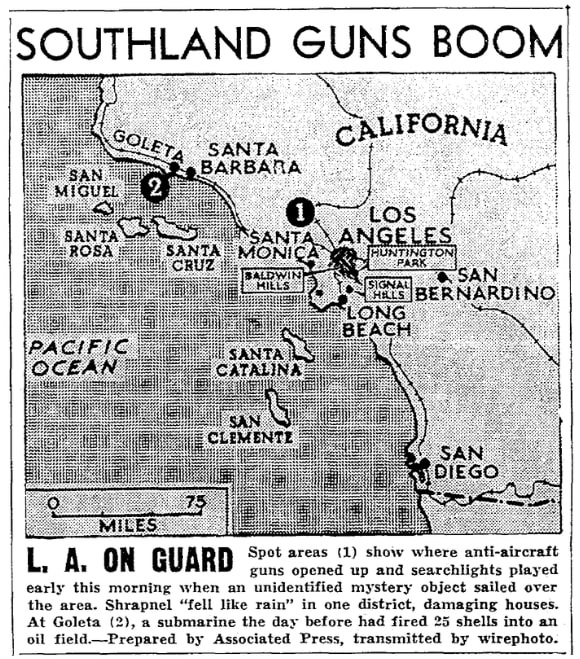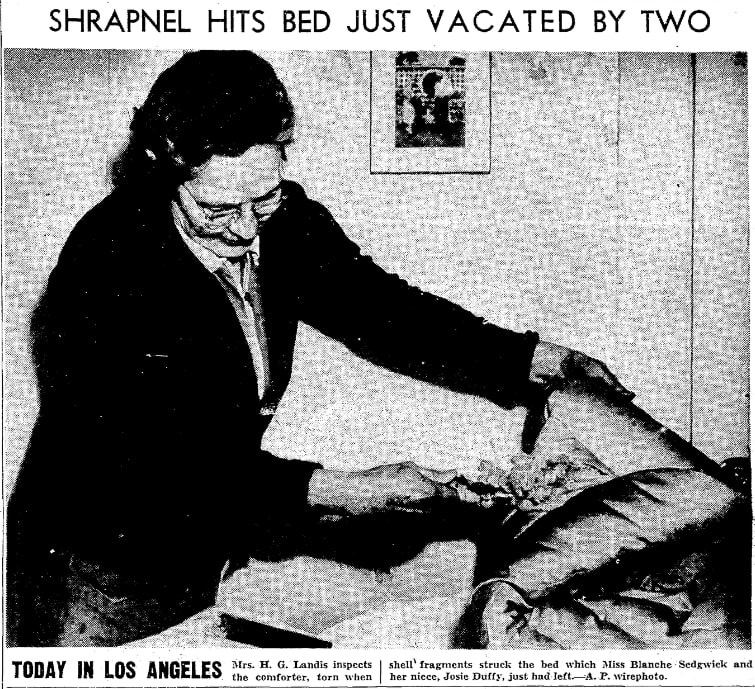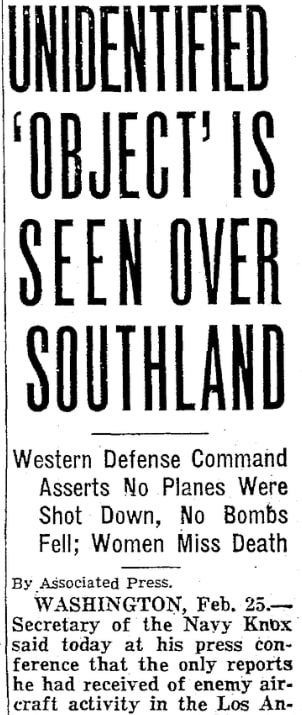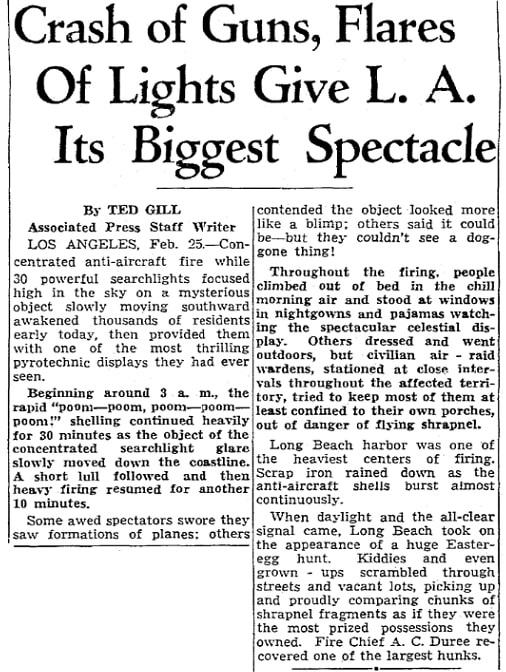Just 80 days after the Japanese attack on Pearl Harbor that launched the U.S. into WWII, anti-aircraft (AA) guns fired into the sky over Los Angeles, California, in the early morning hours of 25 February 1942. That the “Battle of L.A.” happened is a fact; more than 1,400 AA shells were fired in the pre-dawn darkness. But what exactly the battle was about remains a mystery to this day.

Were Japanese airplanes – flying from some secret base in northern Mexico, or perhaps launched offshore from submarines – really attacking L.A.? Was an extraterrestrial spacecraft, a UFO from some distant planet, visiting the Earth? Or was the whole thing an example of “war nerves” frayed to the breaking point?
This much is clear: on the night of 23 February 1942, a Japanese submarine surfaced off the California coast north of L.A., near Santa Barbara, and shelled the Ellwood oil field – raising fears of a large-scale Japanese attack on the West Coast of America. The next night, February 24, officials began to believe that attack was taking shape.
It began with an alert issued by naval intelligence at 7:18 that evening warning that an attack was possible. Later that night, radar detected an unidentified flying object approaching Los Angeles. As it slowly drew near the coast, security was heightened and tension increased. Anti-aircraft crews were put on alert at 2:15 the morning of February 25, and a blackout was ordered ten minutes later.
Slowly the suspicious – and, many were convinced, menacing – blip on the radar screen approached L.A. Around 3:00 in the morning the city was plunged into terror as air raid sirens wailed, powerful searchlights probed the night sky, and AA guns roared into action. Frightened residents rushed out of their houses, only to be ordered back inside by air raid monitors posted throughout the neighborhoods. The shelling was so intense that chunks of shrapnel began raining down upon the city.

But what were they shooting at? Some residents later claimed they saw a few airplanes passing overhead – others swore they saw large formations of planes moving directly toward the city. Others say they saw a strange, blimp-like object caught in the spotlights’ glare. If there were enemy planes, there were no reports of any bombs being dropped anywhere – nor were any aircraft shot down. Shortly after 7:00 that morning the “all clear” signal was given.
A 1983 report from the U.S. Office of Air Force History concluded there really was something in the sky over L.A. that night, but stated it was probably just a weather balloon – and all the resulting air raid sirens, searchlights, and AA gunfire were the result of “war nerves.”
The following two newspaper articles were published by the Seattle Daily Times (Seattle, Washington) on the front page of its 25 February 1942 issue under the banner headline:
‘A. A.’ SHELLS HIT HOMES IN MYSTERY L.A. ‘RAID’
Note the brief mention in one of these articles that several Japanese were “detained for questioning” and turned over to the FBI.
This little detail takes on an ominous note when one realizes the notorious American WWII policy of internment of Japanese-Americans began the week after the “Battle of L.A.,” a program in which more than 100,000 Japanese-Americans on the West Coast – over 60% of whom were American citizens – were turned out of their homes and businesses and forced into concentration camps. In 1988 Congress passed legislation saying the internment of Japanese-Americans was the result of “race prejudice, war hysteria, and a failure of political leadership,” and began a program of reparations to the internees and their heirs.

UNIDENTIFIED ‘OBJECT’ IS SEEN OVER SOUTHLAND
Western Defense Command Asserts No Planes Were Shot Down, No Bombs Fell; Women Miss Death
By Associated Press.
WASHINGTON, Feb. 25. – Secretary of the Navy Knox said today at his press conference that the only reports he had received of enemy aircraft activity in the Los Angeles area last night were that it was “just a false alarm.”
“There were no planes over Los Angeles last night, at least that’s our understanding,” Knox declared. “None has been found and a very wide reconnaissance has been carried on.”
By Associated Press.
SAN FRANCISCO, Feb. 25. – No bombs were dropped and no planes were shot down during the anti-aircraft firing in the Los Angeles area early today, the Western Defense Command announced.
“Cities in the Los Angeles area were blacked out at 2:25 a.m. today on orders from the 4th Interceptor Command, when unidentified aircraft were reported in the area,” the Western Defense Command said.
“Although reports are conflicting and every effort is being made to ascertain the facts, it is clear that no bombs were dropped and no planes were shot down.
“There was a considerable amount of anti-aircraft firing. The all-clear signal came at 7:21 a.m.”
By United Press.
LOS ANGELES, Feb. 25. – An air-raid warden in Gardens, 10 miles southwest of here, said the fire of anti-aircraft guns appeared to be concentrated on what he described as a big bag that looked something like a balloon. The warden said he saw the bag torn to shreds and settle down to earth.
By Associated Press.
LOS ANGELES, Feb. 25. – Anti-aircraft guns thundered over the metropolitan area early today for the first time in the war, but hours later what they were shooting at remained a military secret.
An unidentified object moving slowly down the coast from Santa Monica was variously reported as a balloon and an airplane.
Some observers asserted they saw two planes over Long Beach.
(A United Press dispatch received by The Times said shrapnel “fell like rain” in one district. The dispatch described the “object” seen in the air as possibly an escaped barrage balloon.)
Damage from Shells
Army intelligence, although uncommunicative, scoffed at reports of civilian observers that as many as 200 planes were over the area.
There were no reports of bombing, but several instances of damaged property from anti-aircraft shells.
A garage door was ripped off in a Los Angeles residential district and fragments shattered windows and tore into a bed, where a few moments before Miss Blanche Sedgwick and her niece, Josie Duffy, had been sleeping.
A Santa Monica bomb squad was dispatched to remove an unexploded anti-aircraft shell in a driveway there.
An official source which declined to be quoted directly told the Associated Press that United States Army planes quickly went into action. Later, however, another official said no United States craft had taken off because of possible danger from the Army’s own anti-aircraft fire.
Wailing air-raid sirens at 2:25 a.m. awakened most of the metropolitan area’s 3,000,000 citizens. A few minutes later, they were treated to a gigantic Fourth-of-July-like display as huge searchlights flashed along a ten-mile front to the south, converging on a single spot high in the sky.
Moments later the anti-aircraft guns opened up, throwing a sheet of steel skywards.
Tracer bullets and exploding shells lit the heavens.
Eight Japanese, several described by police as aliens, were detained for questioning as widespread investigations were started into reports, many of them from official civilian air-raid wardens, that lights suspected of being possible signals to the enemy were seen blinking from vantage points throughout the entire blacked-out area.
Flares Single, in Groups
These reports said flares were sent up singly and in series of three to five. Search was instituted for burned residue that might come from the suspected signals but none was found immediately. The reports came from such localities as Beverly Hills, Baldwin Hills, Tarzana Hills, Burbank, Redondo Beach, Hermosa Beach, Point Fermin at San Pedro and numerous points in the hills inland from the coast.
Three Japanese, two men and a woman, were seized by police at the beach city of Venice on suspicion of signaling with flashlights near the pier. They were removed to Federal Bureau of Investigation headquarters, where Richard B. Hood, local chief, said “at the request of Army authorities we have nothing to say.”
A Long Beach police sergeant, E. Larson, 59 years old, was killed in a traffic accident while en route to an air raid post.
Henry B. Ayers, 63-year-old state guardsman, died at the wheel of an ammunition truck during the blackout. Physicians said a heart attack apparently was responsible.
Thousands Late to Work
It was broad daylight before the all-clear sounded at 7:19 a.m.
Late home-goers and early workers, who had been flagged down by air-raid wardens, started moving.
Soon traffic was snarled. Thousands of Angelenos were an hour or more late to their jobs.
The blackout was the first covering the metropolitan area since the first week of the war.
There were isolated instances of failure to comply with blackout regulations. Neon signs were left glowing inside stores. Traffic signals continued to flash in some areas.
Radio stations went off the air with the first alert, and were not permitted to resume broadcasting until 8:23 a.m.
‘Object’ Travels Slowly
There was speculation, meanwhile, that the unidentified object might have been a blimp – although veteran lighter-than-air experts in Akron, Ohio, the nation’s center of such construction, said Japan was believed to have lost interest in such craft following experiments soon after the First World War. These sources said inability to obtain fireproof helium was behind discarding of the plans.
Observers lent some credence to the blimp theory by pointing out that the object required nearly 30 minutes to travel 20 or 25 miles – far slower than a plane.
Mrs. H. G. Landis telephoned police that fragments of metal fell about her home and “a chunk of something” dug a hole in her back yard. An arms expert said the fragments were from an anti-aircraft shell.
A newspaper man at San Pedro said airplanes passed over the Los Angeles-Long Beach harbor area. The craft were not identified.
No Bombing Attempt
A newspaper man at San Pedro said the object moved south over the Los Angeles-Long Beach harbor area.
There were no reports of any attempt to bomb this area from the air, although many war-vital factories, shipyards and other defense industries were on the route the object followed.
Although some watchers said they saw airplanes in the air, semi-official sources said they probably were the Army’s pursuits.
All of the action, clearly spotlighted for ground observers by 20 or 30 searchlights, was just a few miles west of Los Angeles proper.
Observers said the object appeared to be 8,000 feet or higher.
Firing, first heard shortly after 3 a.m., ceased suddenly at 3:30 a.m. after the object disappeared south of Signal Hill, at the east edge of Long Beach. Anti-aircraft guns fired steadily for two-minute periods, were silent about 45 seconds, and continued that routine nearly half an hour.
All of Southern California from the San Joaquin Valley to the Mexican border was blacked out. Los Angeles doused its lights first, at 2:25 a.m. San Diego, just 17 miles from the border, did not receive its lights-out order until 3:05 a.m.
Unofficial sources said Army officials at Riverside, 40 miles east of Los Angeles, ordered the black out.
It came 32 hours after a submarine fired 25 shrapnel shells at the Ellwood tidelands oil field during President Roosevelt’s war address to the nation Monday night. Damage in that attack was negligible – about $500 to an oil-well’s engine’s housing and power lines. Only two of the shells scored hits; 23 fell harmlessly into pastures, foothills and the beach.

Crash of Guns, Flares of Lights Give L.A. Its Biggest Spectacle
By Ted Gill
Associated Press Staff Writer
LOS ANGELES, Feb. 25. – Concentrated anti-aircraft fire while 30 powerful searchlights focused high in the sky on a mysterious object slowly moving southward awakened thousands of residents early today, then provided them with one of the most thrilling pyrotechnic displays they had ever seen.
Beginning around 3 a.m., the rapid “poom – poom, poom – poom – poom!” shelling continued heavily for 30 minutes as the object of the concentrated searchlight glare slowly moved down the coastline. A short lull followed and then heavy firing resumed for another 10 minutes.
Some awed spectators swore they saw formations of planes; others contended the object looked more like a blimp; others said it could be – but they couldn’t see a doggone thing!
Throughout the firing, people climbed out of bed in the chill morning air and stood at windows in nightgowns and pajamas watching the spectacular celestial display. Others dressed and went outdoors, but civilian air-raid wardens, stationed at close intervals throughout the affected territory, tried to keep most of them at least confined to their own porches, out of danger of flying shrapnel.
Long Beach harbor was one of the heaviest centers of firing. Scrap iron rained down as the anti-aircraft shells burst almost continuously.
When daylight and the all-clear signal came, Long Beach took on the appearance of a huge Easter-egg hunt. Kiddies and even grownups scrambled through streets and vacant lots, picking up and proudly comparing chunks of shrapnel fragments as if they were the most prized possessions they owned. Fire Chief A.C. Duree recovered one of the largest chunks.
Note: An online collection of newspapers, such as GenealogyBank’s Historical Newspaper Archives, is not only a great way to learn about the lives of your ancestors – the old newspaper articles also help you understand American history and the times your ancestors lived in, and the news they talked about and read in their local papers. Did any of your family serve in World War II? Please share your stories with us in the comments section.
Related Articles:

When I was at a museum, I think it was the Smithsonian, there was a display about balloon bombs that were sent to California by the Japanese. From Wikipedia: “From late 1944 until early 1945, the Japanese launched over 9,300 fire balloons.” They were not very successful and if I remember the museum display correctly only two people were killed, but I may not be remembering it correctly. Wikipedia says one woman and five children were killed.
Thanks for writing us, Deborah, and contributing to the story.
Hi Deborah-several years ago, I do not remember if it was 10 or more years ago, there was a program on TV. I do not remember the name of the program but it did a one hour program about the balloon fire bombs that was flying over from Japan over to the West Coast of America. There was a group of young people that went on a picnic that was sponsored by some church. The minister and his wife took the kids to a location and one of the kids picked up the balloon. Will the bomb went off and if I am correct, the minister and his wife and the youths were all killed. Here many years later a person was walking in woods and did find a piece of the fabric that was used to make the bombs. That person contacted the program and asked for help in the research. That man who found the material was retired military. He knew about the story. I did not even know about the material until I saw the program. During the war the Japanese children spent several hours at school in morning and then went to the factory to help build the bombs. I wish I can remember the name of program. But as a person starts to get old, what goes first? The mind. I think my has. LOL. If someone out there knows the name of the program, please let us know the name of the show. I would like to know.